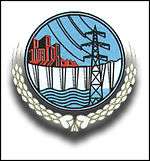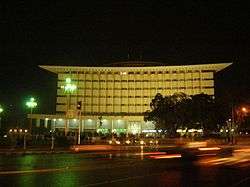Water & Power Development Authority
The Pakistan Water & Power Development Authority (WAPDA) (واٹر اینڈ پاور ڈیولپمنٹ اتھارٹی) is a government-owned public utility maintaining power and water in Pakistan, although it does not manage thermal power. WAPDA includes Tarbela and Mangla dams among its resources. Its headquarters are in Lahore.
| WAPDA (واٹر اینڈ پاور ڈیولپمنٹ اتھارٹی) | |
 WAPDA logo | |
 WAPDA House, Lahore, Pakistan | |
| Agency overview | |
|---|---|
| Formed | February 22, 1958 |
| Type | Power and Hydrology |
| Jurisdiction | Federal Government of Pakistan |
| Headquarters | WAPDA House, Lahore, Pakistan |
| Agency executive | |
| Parent agency | Ministry of Water Resources (Pakistan) Ministry of Energy (Power Division) |
| Website | www |
History
WAPDA was established by an act of parliament in 1958[2] to unify the maintenance of infrastructure previously overseen by provincial agencies. Its Chairmen included outstanding civil servants like Ghulam Ishaq Khan, Ghulam Faruque Khan and Aftab Ghulam Nabi Kazi who were subsequently President of Pakistan, Minister for Commerce and Economic Adviser, respectively. In October 2007, thermal power management was split into the newly formed Pakistan Electric Power Company (PEPCO).
WAPDA Water vision 2025
WAPDA has formulated a comprehensive $25–33 billion National Water Resource and Hydropower Development Programme, entitled Water Vision 2025. The Water Vision 2025 projects are expected to generate 16,000 MW of hydroelectricity. Other goals are to prevent water shortages, limit drought and increase water storage for a growing population. Five massive hydropower projects have been announced by the President of Pakistan; these are to be completed by 2016, with a generation capacity of 9,500 MW. Two of the projects are ready for construction, while three are in the stages of feasibility studies and preparation of tender documents.[3]
Water Vision 2025 consists of three phases. Phase I was expected to start in 1993 but was delayed. The priority of water sector projects under Phase I of Water Vision 2025 are Gomal Dam (Khyber Pakhtunkhwa) , Mirani Dam and Mithan Kot Barrage at Kachhi Canal (Balochistan) raising of Mangla Dam (Azad Kashmir), Greater Thal Canal phase I (Punjab) and Thar/ Rainee Canals phase I (Sindh). The total cost of these Phase I projects will be $2.467 billion with a construction period of five years. Under Phase II, Hingol Dam, Balochistan Dam and Satpara Dam (Northern Areas), Chashma Right Bank Canal and Khurram Tangi Dam (NWFP), phase II of the Greater Thal Canal Akhori Dam and Sanjwal Dam (Punjab), phase II of Thar/Rainee Canals, Gajnai and Sehwan Barrage (Sindh) will be completed in 3–6 years, except Basha Dam, which will take 8–10 years for its completion. The total cost of Phase II projects will be $8.94 billion. These 11 projects will have a storage capacity of 12,790,000 acre feet (15.78 km3), would generate over 3362 mW of power, and would irrigate 14000 square kilometers of land. Under Phase III, Yugo Dam, Skardu Dam, Dhok Dam, Rohtas Dam, Naulang Dam and Khadji Dam will be completed and under phase IV Katzarah Dam will be completed insha'Allah.[4]
See also
- List of electric supply companies in Pakistan
- Electricity sector in Pakistan
- Economy of Pakistan
- Alternative Energy Development Board
- National Electric Power Regulatory Authority
- Karachi Electric Supply Company